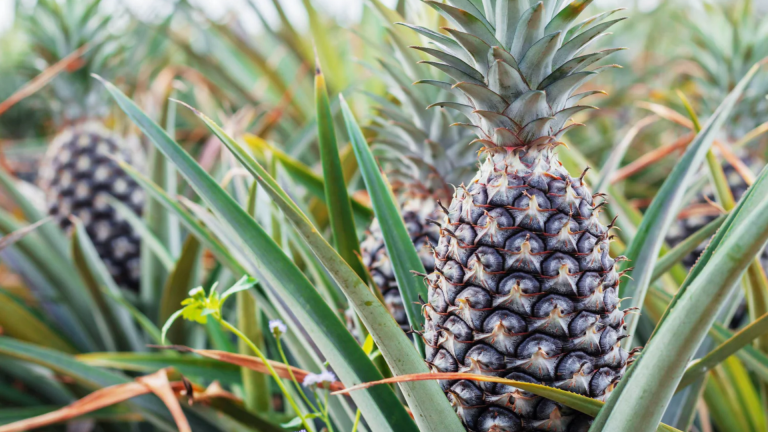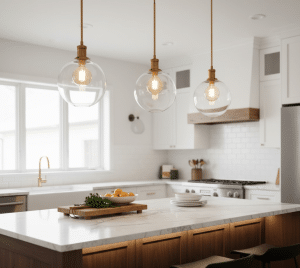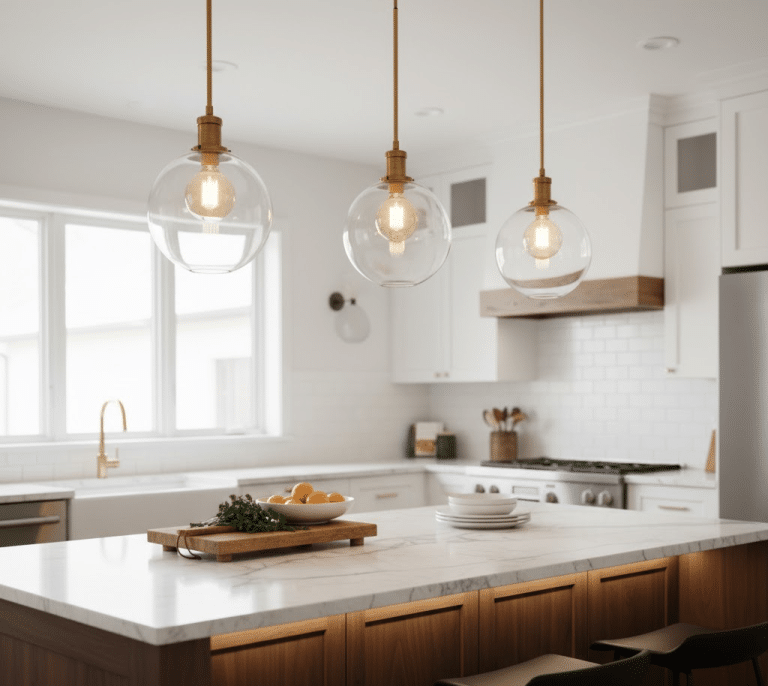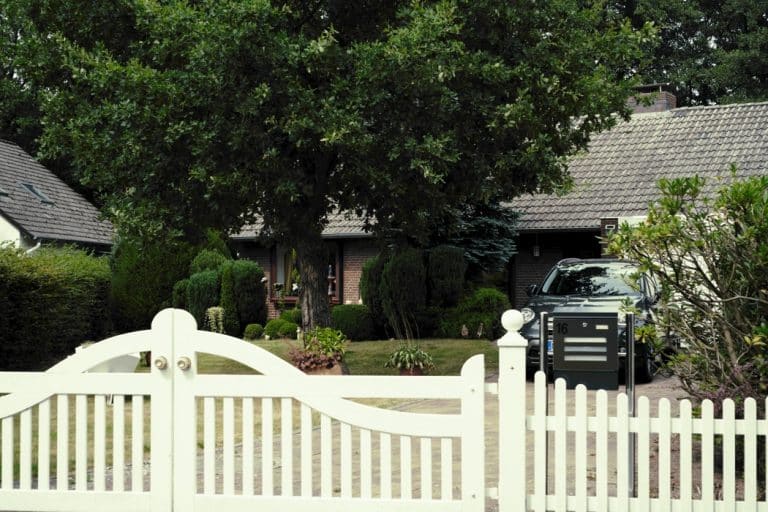Are you struggling to keep your pineapple bromeliad healthy? You’re not alone. Many plant owners find these unique houseplants challenging to care for properly.
In this guide, you’ll learn:
- The right soil mix for pineapple bromeliads
- How much water and light do they need
- The best temperature and humidity levels
- Common problems and simple solutions
As a plant specialist with over 15 years of growing bromeliads, I’ve tested these methods in various conditions. These tips work for both beginners and experienced plant owners.
Your pineapple bromeliad can thrive with the right care. By the end of this article, you’ll have the knowledge to help your plant grow strong and possibly even produce its striking fruit-like bloom.
Let’s get your bromeliad looking its best!
What Is a Pineapple Bromeliad?
The pineapple bromeliad is a houseplant that belongs to the bromeliad family. It’s a close cousin to the pineapple fruit we eat. I first came across this plant during a visit to a local nursery and was instantly drawn to its unusual shape. These plants come from tropical parts of South America, mainly Brazil.
They grow naturally in warm, humid places where they attach to trees or rocks. What makes them stand out? Their leaves form a rosette pattern – think of a star when you look at them from above. The leaves are stiff and often have spiky edges.
But this is the real show-stopper that the center of the plant produces a flower spike topped with a small, pineapple-like structure. This is why we call it a pineapple bromeliad! Some varieties even have brightly colored leaves in red, orange, or purple. These colors help them stand out in their natural homes.
You might be surprised to learn that these plants don’t need soil to grow in nature. They get water and nutrients from the air and rain that collects in their leaf cups.
Have you ever seen one up close? The resemblance to a small pineapple is quite striking!
Ideal Light Conditions for Pineapple Bromeliads
Finding the Perfect Spot
Pineapple bromeliads need the right amount of light to stay healthy. I’ve found that these plants do best in bright, indirect light. You can place them near an east or west-facing window where they’ll get morning or late afternoon sun.
If you keep your plant outdoors, choose a spot under a tree or on a patio where it gets filtered light. Direct midday sun can burn the leaves, so some shade is needed during the hottest parts of the day.
Light Requirements
These plants need about 6-8 hours of bright light daily. In my experience, they can handle some direct morning sun, but not the harsh afternoon rays.
Too little light? Your bromeliad will grow slowly and might not produce its colorful center. Too much direct sun? The leaves will get brown, crispy patches.
Seasonal Adjustments
You’ll need to change your plant’s location as seasons shift. During winter, I move my bromeliads closer to windows to catch more light. In summer, I pull them back a bit to protect from the intense sun. Have you noticed your plant leaning toward the light source?
This means it’s reaching for more brightness. Simply turn the pot every few days to help it grow evenly. A light meter can help if you’re unsure about your home’s light levels. Aim for 1,500-2,500 lux for these plants to thrive.
How Often to Water a Pineapple Bromeliad?
The Right Way to Water
Watering a pineapple bromeliad is different from most houseplants. These plants have a natural cup formed by their leaves in the center. I always pour water directly into this central cup to mimic how they get water in nature. Fill the cup about halfway with room-temperature water.
The plant will absorb what it needs through its leaves. You should also lightly water the soil around the base, but the cup is most important. Never use cold water as it can shock the plant. I let tap water sit out overnight to reach room temperature and allow chlorine to evaporate.
Seasonal Watering Schedule
During spring and summer, when the plant is growing, you’ll need to water more often. I check my bromeliad’s cup twice a week and refill when it’s nearly empty. In fall and winter, the plant needs less water.
You might only need to fill the cup once every 7-10 days. The soil should almost completely dry out between waterings during cooler months. Have you noticed yellow leaves? This often means too much water.
Drainage and Common Mistakes
Make sure your bromeliad has good drainage. I use pots with holes and a well-draining soil mix. Without proper drainage, root rot can develop quickly. The most common mistake is letting water sit in the leaf cup for too long.
After 3-4 days, empty any remaining water and refill with fresh water. This prevents bacteria growth and rot. If the leaf tips turn brown, the air might be too dry. Try misting around (not on) the plant to increase humidity.
Temperature and Humidity Needs
The Perfect Temperature Range
Pineapple bromeliads prefer warm conditions similar to their native tropical habitat. I’ve found they grow best when kept between 65-85°F (18-29°C). They can handle brief periods outside this range, but not for long. These plants don’t like sudden temperature changes.
Keep them away from heating vents, air conditioners, and drafty windows. Even a brief cold spell below 55°F (13°C) can damage the leaves and slow growth. At night, a slight drop in temperature is fine. In fact, a nighttime drop of 5-10 degrees can help trigger flowering in mature plants.
Boosting Humidity for Your Plant
Low humidity is a common problem for indoor bromeliads. You can tell your plant needs more moisture in the air if the leaf tips begin to brown or crisp up. I use several methods to increase humidity: Place the pot on a tray filled with pebbles and water.
Make sure the pot sits on the pebbles, not in the water. Group your bromeliad with other plants. Plants naturally release moisture, creating a mini humid zone. Have you tried a small humidifier? It’s my favorite solution during dry winter months.
Protecting from Environmental Stress
Cold drafts can quickly harm your bromeliad. During winter, move your plant away from doors and windows that let in cold air. Summer brings its own challenges. Keep your plant out of hot, dry air currents from fans or air conditioners. If you notice the leaves curling inward, the air might be too dry.
A quick mist around the plant (not directly on it) can provide temporary relief while you work on a more permanent humidity solution. When moving your bromeliad outdoors for summer, do it gradually. I place mine in shade for a few hours each day, slowly increasing sun exposure over two weeks to prevent shock.
Best Soil and Potting Mix for Pineapple Bromeliads
Pineapple bromeliads need well-draining soil that won’t stay soggy. I mix equal parts orchid bark, perlite, and peat moss to create the perfect growing medium. This combination allows air to reach the roots while holding just enough moisture. Never use regular garden soil for these plants.
It becomes too compact and holds too much water, which can rot the roots. If you don’t want to mix your own soil, look for orchid or bromeliad-specific potting mixes at garden centers. For pots, choose ones with large drainage holes. I prefer clay or terracotta pots because they allow excess moisture to evaporate through their walls.
Plastic pots work too, but you’ll need to be more careful with watering. The pot size should be just slightly larger than the plant’s root ball. Too much extra space can lead to soggy soil and unhappy plants. Remember to place a saucer under the pot to catch water, but don’t let your bromeliad sit in standing water.
How to Encourage Blooming in A Pineapple Bromeliad?
Pineapple bromeliads can make beautiful houseplants, and their blooming process is particularly fascinating as it eventually produces a small pineapple fruit.
Bloom Cycle Basics
Pineapple bromeliads typically bloom once in their lifetime. The colorful structure that looks like a small pineapple is actually the flower. I’ve found that most plants bloom when they’re about 2-3 years old, but this can vary.
The bloom can last for several months, much longer than many other houseplants. After blooming, the mother plant will slowly begin to die back, but don’t worry! This is normal and part of its life cycle.
Triggering the Bloom
You can encourage your bromeliad to flower with a few simple tricks. Consistent bright light is the most important factor. I place mine where they get bright, indirect light for at least 6 hours daily. A gentle fertilizer routine helps, too. Use a bromeliad or orchid fertilizer at 1/4 strength once a month during spring and summer.
An interesting method I’ve used successfully place a ripe apple near your bromeliad and cover both with a clear plastic bag for about a week. The apple releases ethylene gas, which can trigger flowering.
After the Bloom
Once your bromeliad has finished flowering, don’t remove the dying bloom too quickly. I wait until it turns completely brown and begins to dry out. Look for “pups” growing at the base of the plant. These are baby bromeliads that will replace the mother plant.
When these pups reach about 1/3 the size of the mother plant, you can separate them to grow new plants. The mother plant will gradually fade, but it’s doing an important job of sending energy to the new pups. Keep caring for it as usual until the pups are large enough to survive on their own.
Is Pineapple Bromeliad Safe for Pets and Kids?
Good news! Pineapple bromeliads are non-toxic to cats, dogs, and humans. I’ve kept these plants in homes with pets and children for years without problems. While the plant itself isn’t poisonous, there are still a few safety points to consider.
The leaves often have small spines along their edges that could scratch curious fingers or paws. These aren’t dangerous, but might cause mild discomfort if handled roughly. If you have pets or small children, place your bromeliad on a high shelf or plant stand.
This prevents accidental tipping and keeps those spiky edges out of reach. I always make sure to keep the fertilizer and plant care products stored safely away from children and pets. These chemicals, not the plant, pose the real danger.
One last tip: some cats love to chew on plants regardless of toxicity. To protect both your cat and your bromeliad, try placing some pet-safe cat grass nearby as an alternative.
Conclusion
Growing a pineapple bromeliad might seem tricky at first, but with these basic care tips, you can help your plant thrive. I’ve seen even beginners succeed with these plants once they understand the basics.
Remember the key points: bright indirect light, water in the central cup, well-draining soil, and proper humidity. These four elements form the foundation of good bromeliad care. Be patient with your plant. The beautiful bloom is worth the wait!
When your bromeliad produces pups, you’ll have the chance to start the growing cycle all over again. This is one of my favorite parts of bromeliad growing—one plant becomes many over time.
Have questions about your specific plant? Check with your local garden center or join an online plant group. Fellow bromeliad fans can offer helpful advice for your growing conditions.
What will you try first with your pineapple bromeliad?
















